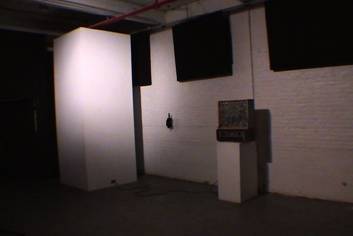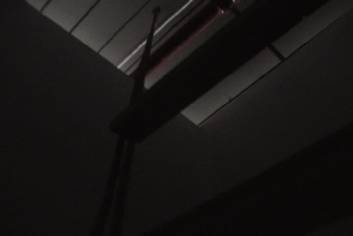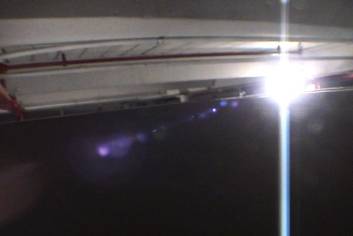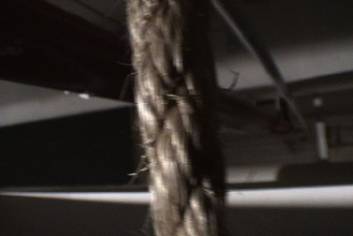Presented at the Berwick Research Institute, September 14, 2002.
Installation and Research Report completed as part of the Berwick’s Artist in Research program.
General Background Information
Berwick Research Institute
The Berwick Research Institute is a non-profit, 501C.3 tax-exempt arts organization located in Roxbury, MA. The Berwick hosts art shows in a variety of media, including film, video, installation, sound and new music, in addition to the traditional art forms of painting, drawing and sculpture. In addition, the Berwick hosts educational workshops and community events. The Berwick’s events serve a diverse community of artists, students, and local residents.
Artist in Research Program
The Berwick’s Artist in Research program was created to provide an ongoing environment in which to foster research in the arts. The Berwick provides studio space and facilities to artists of all media for four to six week terms. The Research term may or may not result in a public showing of work. However, the Artist in Research is expected to complete a research report, describing their activities during their term.
Jessica Rylan
I began working in the medium of sound and electronic art in 1996. In July 2002, I completed my MFA in Music at Bard College. My past projects have included sound installations, analog electronic musical instruments of my own design, sound recordings, and noise performances utilizing electronic devices in novel ways. The sonic focus of my work is typically on texture and duration, rather than pitch, melody, or harmonic progression. The installations, performances, and electronic devices involve the physical body as an integral element of the experience.
to topOverview of Red Sky at Night
General Description
The installation was composed of two parts, a column with integral speaker cabinet, and a modular synthesizer and amplifier resting on a nearby pedestal. The column was eleven feet tall, four feet square on the outside, and open at the top. There was an opening on the back side of the column approximately twenty inches wide and three feet tall. Through this opening the viewer entered the installation. The internal dimension was three feet square, large enough for only one person. All angles of the column, internal and external, were perpendiculars. The column was placed in a corner of the gallery.
Inside the column was a rope ladder, suspended from the ceiling and secured to the floor. The ladder had eight wooden rungs, spaced approximately nine inches apart. There was enough space between the top of the column and the ceiling that viewers were able to look out over the rest of the space from the top of the ladder, if they wished. The floor of the column was a speaker cabinet, housing a large-diameter speaker. The face of the cabinet was also used to anchor the bottom of the rope ladder. The cabinet had five narrow slots cut into it, through which the speaker communicated. This way the speaker was hidden, and protected.
On a nearby pedestal were the modular analog synthesizer, and a power amplifier. The amplifier connected to the speaker via a heavy cable that plugged in to a jack mounted at the base of the column. The synthesizer produced a mix of four steady low-frequency tones, which were heard through the speaker. Between the pedestal and the column, a pair of gloves hung on a book, which viewers could don if they were worried about the rope ladder hurting their hands.
Goals for the Installation
Overall, I wanted to produce a very well-crafted work. Many of my past works have been fairly rough in execution. This was partly a stylistic choice, and partly the process of learning by doing. The rough, obviously hand-built style is particularly effective with electronic devices, simply because of the incredible rarity of hand-built electronic devices, and the ubiquity of mass-produced ones. By constructing the column in a straightforward manner, with simple angles, it had little personality of its own. The structure thus served primarily as a location for a physical experience, activated upon the viewer’s entrance.
I wanted the ladder to be something of a challenge, and somewhat uncomfortable, but not impossible or dangerous. For this reason, I used wooden rungs, instead of constructing an all-rope ladder. In addition to a physical challenge, the ladder was intended as a pathway through a sonic field. The experience of climbing the ladder would correlate with, and complement, the viewer’s aural experience.
Details of the sonic material
The four tones produced by the speaker were each constant pitches. However, their interaction produced strong beating and wavering patterns. The pitches were carefully tuned in order to fulfill several functions. On the one hand, I wanted the sound inside the enclosure to be quite different from the sound that spread out into the rest of the space. In addition, I wanted the sound to change as the viewer climbed the ladder, so that an aural journey took place. These two tasks were accomplished by tuning the oscillators in relation to the physical properties of the room, and the enclosure, respectively. Lastly, I tuned the oscillators in reference to each other, to produce beating effects of various lengths. Thus, there was an uncomfortable vibration occurring about six times a second, fairly regular pulses occurring every 1-2 seconds, crescendos and decrescendos lasting 6-10 seconds, and longer overall patterns, some of which lasted 60 seconds or more.
The installation had strong physical components, but in addition the various time scales employed stretched the viewer’s attention to the realm of active perception and memory. Three of the oscillators were tuned within a few Hertz of each other (the interval of a major second), while the fourth was tuned approximately one and a half octaves above. The three low frequencies had approximately equal amplitudes, while the higher frequency was much quieter. The higher frequency subjectively held its pitch better than the three lower frequencies, and acted like a constant beacon that was just discernible.
The specifics of the tuning were as follows. A triangle wave oscillator was tuned to 60 Hz. The frequency was slowly swept lower. Two strong resonances were passed, in the low 50’s. Slightly below these two was a third resonance, not as loud but with a stronger feeling. That was the central frequency in the tuning. Next, a sawtooth oscillator was tuned to a rough unison with the triangle, then adjusted for a long beat, approximately five seconds. A second sawtooth was then tuned roughly to the first two oscillators. Then the pitch of this oscillator was delicately adjusted so that it beat with the triangle about twice per second, and with the other sawtooth about once every one and a half seconds. These three oscillators were mixed together, and passed through a low-pass filter, to remove their harmonics. The fourth oscillator, a sine oscillator, was tuned one octave and a major seventh above the master triangle oscillator. Its volume was adjusted to be just audible.
to topAlternate Project Ideas
The initial idea proposed to the Berwick was to activate the entire gallery, with four or more loudspeakers placed around the room, and several microphones. The sound source was to be generated by the filtered feedback of the microphones, amplifying selected natural resonances of the room. The concept was to carefully tune the feedback to set up a precarious balance, which would be disturbed by the viewer’s body moving about the space and interfering with the sound waves. The idea was abandoned upon further consideration, because of the simple fact that the gallery is too big for one person’s body to have any effect on the acoustics. While the acoustics would certainly be effected by the presence of many bodies in the room, no one individual could have an effect, so the overall experience would not be primarily an individual experience.
A second idea was to actually construct a space small enough that one person could have a noticeable effect on the space’s acoustics. The space was envisioned as a short hallway, perhaps seven feet high, ten feet long, and three feet wide. One or at most two people would comfortably fit into such an enclosure, and their effect on the acoustics would control the overall sounds produced, through careful tuning of feedback. Eventually the feedback idea was abandoned as being unworkable given the equipment and time constraints at hand. This kind of large-scale project based on feedback awaits adequate time and funding.
The hallway idea was refined to utilize speakers at each end of the hallway, producing different low-frequency tones. The tones would be chosen to be slightly more and slightly less than ¼ wavelength of the length of the hallway. Thus, the tones would beat against each other, but the beats would subjectively shift as one walked from one end of the hall to the other, according to the sound pressure of each frequency at any particular place. One of the main problems with this idea was that to use frequencies as low as I wanted to use, the hallway would have to be longer than I wanted.
In addition, the more I thought about it, the less I liked the idea of a horizontal orientation. As I thought about a small enclosed space, I thought more about the relative shape of a human being: tall and thin. Thus, the idea of a column. The added benefit of a column is that it took up less floor space in the gallery, so I was able to leave the installation in place for a longer time than I could have left a structure with a larger footprint.
to topTuning and Resonance
The Research component of Red Sky at Night revolved around tuning and resonance, specifically the resonance of the column. The sonic results of the experiment were not as anticipated, but in terms of learning, the experiment was a success.
Sound is simply a manifestation of rapidly-repeating vibrations. The primary medium through which humans experience sound is the vibration of air. In free space, sound tends to spread out and diffuse. In addition, sound disappears through the friction between the vibrating air and the space’s boundaries, be that the floor or the ground. Sound waves can also be reflected, particularly by hard, smooth surfaces. In the condition approaching unenclosed space, ie outside, sound spreads in all directions and is quickly lost. In a small space designed as a resonator, such as the body of an acoustic guitar, a small amount of energy (for example, a plucked string) may produce a sound that lasts for quite a while. The body of the guitar is specifically designed to vibrate sympathetically over a certain frequency range, and thereby reinforce sounds in that range.
More germane to the resonance of a column is the resonance of a flute or an organ pipe. In either of these cases, the resonant body is the column of air which is contained inside the given enclosure, rather than the enclosure itself. (In contrast to the guitar, where the air inside the chamber is one resonator, and the face and back of the guitar are other important resonators.) When the wave-front reaches the open end of the tube, part of the wave is reflected back down the tube. The mismatch between the impedance of the tube, and the impedance of the open air, allows the opening to act like a leaky boundary.
The fundamental resonance of the pipe is primarily related to its length, but is also influenced by the pipe’s diameter. For an open-ended pipe, like an organ pipe, the fundamental resonance will be the frequency which has the pipe’s length as its quarter-wavelength. In this special case, the wave front reflected by the open end is reflected in phase with the trailing wave, thus adding to the wave’s volume. Reflection at a quarter-wavelength is particularly important, because this is the lowest fundamental resonance of many musical instruments and architectural structures. Reflection at the quarter-wavelength reinforces all parts of the cycle. On the other hand, the half-wavelength is a node for a column, because the reflected wave directly cancels out the generated wave.
The resonances of spaces with other than tubular shapes can be analyzed, but not with my poor grasp of theory. However, rectangular rooms tend to resonate at frequencies corresponding to wavelengths of their dimensions, and whole-number multiples of those wavelengths. One of the first tests I did at the Berwick was to examine the resonances of the entire space, using several speakers and a sine-wave generator. The Berwick’s physical structure yielded many resonances, including those corresponding to the length of the room and its harmonics, the width of the room and its harmonics, and the height of the room and its harmonics. Certain of these resonances were fairly close together, and didn’t necessarily form the kind of intervals I wanted to use in a piece. In addition, the closeness of some resonances encouraged an uncontrollable instability. These problems were a strong catalyst in my decision to build a self-contained, resonant enclosure.
to topEvaluation of the Project
The column I built was similar to an organ pipe, except that it used a pitched transducer (speaker) as the driving element, instead of an air stream, like an organ pipe. I had hoped that my column would behave like a simple organ pipe, that is to have its strongest resonance at the quarter-wavelength. The column eventually had an internal length of ten feet, corresponding roughly to a quarter wavelength of 28 Hz. However, the column’s strongest resonances seemed to be considerably higher than that, probably around 50 Hz. This was probably because of two structural factors. The column was fairly wide, compared to its height, a fact dictated by the Berwick’s physical structure. In addition, the entry into the installation was much larger than ideal. However, the size of the opening was dependent on the comfort of the people who would be entering the installation. An earlier version, shown at an open studio, had a much smaller opening, which was too awkward and difficult to enter. This version had a stronger internal resonance, however.
The resonance of the speaker enclosure was also a factor in the resonance of the column. The speaker’s output rolled off precipitously a little below 32 Hz, so it was really not possibly to test the column at a low frequency. The construction of the speaker enclosure was done primarily by experiment, with a smattering of knowledge as a guide. The enclosure was essentially of the vented variety, that is, a large, empty box, with a vent in the front panel. This style of enclosure has been abandoned in favor of the more-popular ported variety. In a ported speaker, the speaker’s front transmits sound directly, and certain bass frequencies are allowed to leave the box through a tube. This allows for reinforced bass. The frequencies which are reinforced are related to the the length and diameter of the tube. The vented enclosure is essential similar. At the enclosure’s resonant frequency, the speaker’s back-wave exits through the vent in phase with the speaker’s front wave, thus increasing the sound pressure. The resonant frequency is related primarily to the speaker’s characteristics, the volume of the box, and the size of the vent.
Red Sky at Night did not resonate at 28 Hz, which was my goal. The installation did produce a concentrated, high-pressure area in the range of 50 Hz, and the experiences of sound inside and outside the installation were quite different. The column and speaker cabinet remained fairly acoustically dead. The resonance corresponding to the enclosure’s internal dimension of three feet, 370 Hz, did not present a problem. However, the sound did not change as much along the ladder as I had hoped. When tuned to slightly higher frequencies, a little above 60 Hz, the change was much more apparent. As one’s head raised over the top edge, the sound mysteriously dissipated. However, these frequencies were higher than I was interested in, too high to be felt strongly.
A final and very vexing problem related to the oscillators. I had initially planned on building a dedicated bank of four oscillators for the installation. I had intended to build high-stability, low-distortion sine wave oscillators. I planned on using the old-fashioned Wein Bridge circuit, with an incandescent light bulb as a stabilizing element. However, due to time constraints, I had to use my modular synthesizer. The synthesizer has one sine oscillator, one triangle, and two sawtooth. The triangle and sawtooth oscillators were run through a low-pass filter in an attempt to remove some of their harmonics, but the final sound had a lot more high-frequency energy than I had hoped. The speaker cabinet design helped to attenuate these frequencies, but they were still more pronounced than initially planned. Additionally, and more importantly, these oscillators had poor stability. The installation required re-tuning several times a day. This was very inconvenient, especially because the tuning procedure was fairly complicated, and I never got a chance to teach it to anyone else. I was told that people were interested in the installation during Roxbury Open Studios, when I was not available to tune it, but they didn’t experience the installation as I preferred to exhibit it.
Overall, I felt the installation was a success. The installation provided for a fairly unique physical experience. The combination of the slowly undulating frequency, and the swinging rope ladder, inside of a dark, claustrophobic space, gave rise to a strong feeling. In addition, there were many areas to listen to within the sound. There was the wavering of the low tones themselves, the beating of the oscillators’ harmonics, the modulating effects of the strong low-frequency beats on outside sounds, and the spurious high-frequency tones generated by the ear itself. I experienced these high tones as being similar to the sound of yawning, or otherwise relaxing the eustacheon tubes.
Two particularly interesting times with the installation came during its construction. One night, when I had just finished the speaker cabinet, Katya Gorker and I spent several hours listening to different combinations or tones. One particular combination produced a wheezing hough, that would only happen every 45 seconds, and last for five or six seconds. It sounded like an old man on his last breath. In fact, the panting was simply the “chuffing” noise produced by the friction of the vents against the vast quantity of air shooting out. Unfortunately, this effect wouldn’t happen once the speaker was installed in the column. My favorite experience with the installation was listening to it at a low volume by myself at night, while a gentle rain dusted the streets of Dudley outside. As the sound of the rain floated through the open window, the beating of the oscillators gently but firmly tossed the sound around, like a little sailboat boat drifting on the ocean.
to topVideo Stills of Red Sky at Night

Figure 1. The column, synthesizer, and hanging gloves

Figure 2. The entrance to the column

Figure 3. Looking up inside the column

Figure 4. Looking over the top edge

Figure 5. Looking over top edge, rope in foreground